
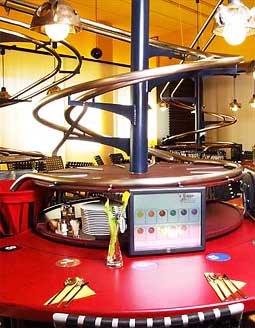
Shades of the future that never was! A restaurant in Nuremberg has done away with waiters (in a completely humane way) by replacing them with a gravity-feed system and networked computers at every table.
The kitchen’s above the dining room. Customers order using touch-screen computers at their tables, and when their food’s ready it slides down gently on spiral rails.
I suppose that to complete the circuit you’d want more rails leading to dishwashers in the basement, but for now it looks like the jobs of buspersons are secure. More here.
This is somehow like the automated parking garage that was designed in Germany a couple of years back. A trend in vertically oriented job reductions?
This entry was posted on Monday, August 27th, 2007
and was filed under Found on the Web
There have been no responses »
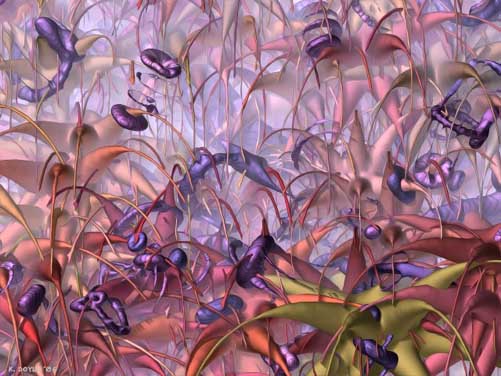
And speaking of the old Amiga days, here’s one of a series of beautiful abstractions by Keith Doyle.
Keith wrote one of the most useful applications I used on the Amiga (“the Director” – a few years before Macromedia fastened on that name). The Director was a version of the BASIC programming language which included powerful extensions for 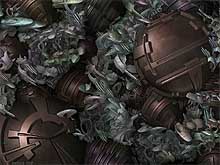 displaying and manipulating graphics and sound. Keith’s always been interested in both art and music.
displaying and manipulating graphics and sound. Keith’s always been interested in both art and music.
Here we see what he’s been up to visually. Many of these images use kaleidoscopic reflections, but others are asymmetrical and nearly representational. Although the scenes they seem to represent are places I haven’t visited since the late seventies. Ahem.
Great stuff!
This entry was posted on Thursday, August 23rd, 2007
and was filed under Computer Graphics
There have been no responses »
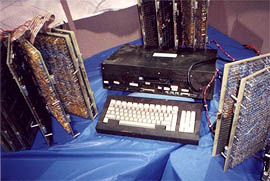 Ars Technica’s History of the Amiga continues with Part 3, in which we finally meet the rest of Amiga Inc.’s team – including R.J. Mical, Carl Sassenrath, Dale Luck, and Dave Needle.
Ars Technica’s History of the Amiga continues with Part 3, in which we finally meet the rest of Amiga Inc.’s team – including R.J. Mical, Carl Sassenrath, Dale Luck, and Dave Needle.
The group is under the gun as they prepare for their computer’s first private showing at CES in 1984. At left we see the prototype of the machine, with each of its three custom chips emulated by enormous breadboard sandwiches.
The operating system is well under way, with Sassenrath’s lean multitasking kernel and Mical’s work on the UI and its interface for developers. But as they near the point where they’ll have an actual product to sell, they’re running out of money. Go forth and reminisce.
This entry was posted on Thursday, August 23rd, 2007
and was filed under Computer Graphics
There have been no responses »
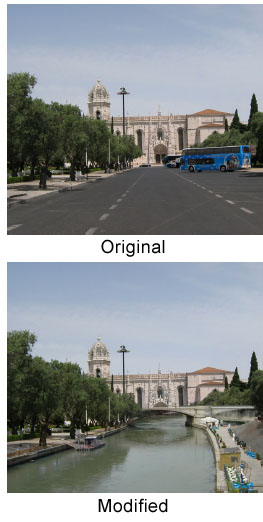 A paper from this year’s SIGGRAPH by James Hays and Alexei Efros (Carnegie Mellon) takes a new approach to digital image “healing” or hole filling. This is a problem faced in many situations, whether it’s restoring a damaged picture, eliminating flaws like a bug on the lens, or just replacing unwanted areas of an image – picture, for example, a plate for a motion picture backdrop in which the makers of a period film want to eliminate modern details.
A paper from this year’s SIGGRAPH by James Hays and Alexei Efros (Carnegie Mellon) takes a new approach to digital image “healing” or hole filling. This is a problem faced in many situations, whether it’s restoring a damaged picture, eliminating flaws like a bug on the lens, or just replacing unwanted areas of an image – picture, for example, a plate for a motion picture backdrop in which the makers of a period film want to eliminate modern details.
What makes this technique unusual is that it doesn’t look for other areas in the image for texture and detail to insert. The software that the authors developed uses a database of 2.3 million unique photographs and – without human intervention – looks for semanitic matches for the area that they chose to replace.
No human tagging or hints were used. The program looked over the entire database for broad matches, then looked more carefully for the best fit. When finished (after about an hour on a single CPU, or five minutes on a cluster of fifteen), the authors were presented with several results to choose from. Their paper shows how completely different those results often were, which is one of the most interesting aspects of the algorithm. They also show us examples of bad matches, in which existing methods provided better results than theirs.
Overall the results are impressive, especially considering that the software has to figure out a lot about the images it’s “looking” at in order for this to work. The larger the database, the better it does.

I think that there are some inherent problems with actually using this sort of technique. Their huge database was acquired from Flickr accounts and so there would obviously be copyright issues; also, because some of the solutions include people – even crowds of them – a commercial use could produce photographs of people without model releases, or even any way of knowing who the heck ended up in the picture. And because it’s hard to figure how else you could assemble a library of millions of source photographs, I think that’s a pretty large hurdle to jump. Still, very interesting.
This entry was posted on Monday, August 20th, 2007
and was filed under Computer Graphics
There have been no responses »
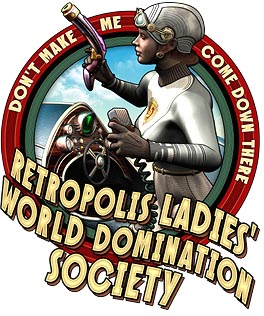 Here’s something I think is pretty fun, even though I can’t exactly wear it myself – women’s T-shirts for the “Retropolis Ladies’ World Domination Society”.
Here’s something I think is pretty fun, even though I can’t exactly wear it myself – women’s T-shirts for the “Retropolis Ladies’ World Domination Society”.
Sugar, Spice, and complete, uncompromising oversight over everything that goes on in the Future That Never Was: that’s the chemical composition of the Ladies’ World Domination Society. Also, they serve tea.
Their motto is “Don’t MAKE me come down there!”
Available (on different selections of shirts) at both the Retropolis Transit Authority and at Celtic Art & Retro-Futuristic Design. Be the first on your block – I just finished ’em today.
This entry was posted on Sunday, August 19th, 2007
and was filed under Works in Progress
There have been no responses »
These don’t happen too often – they’re fairly complex undertakings – but I’ve just added a new Retropolis poster to my Celtic Art & Retro-Futuristic Design site.
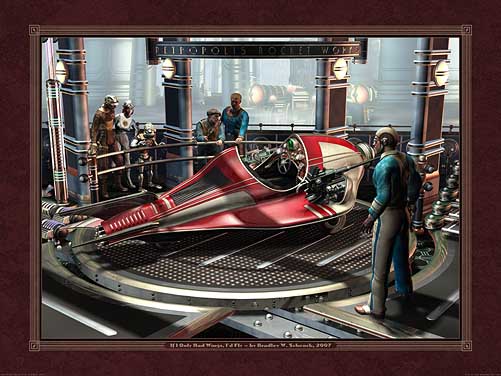
This scene – a sort of car show of the Future That Never Was – showcases one of the rockets I modeled for my Empire State Patrol project. Here I changed its color and dropped it into a variation on the scene I built for my “Skin A Scion” contest entry at Deviant Art.
The poster (18 by 24 inches at 300 DPI) mixes some older and newer characters together, and its title – “If I Only Had Wings, I’d Fly” – marks the second time I’ve named a picture with a quote from Nat Gonella’s “It’s a Pair of Wings for Me”, which still swings after about 66 years. Love that song – and in fact, though I’ve never known how many people noticed, almost all my Retropolis pictures use titles or quotes from popular music of the twenties through the forties. If you figure out why, you can explain that to me.

The poster is available now. An archival print should be available in a few days.
This entry was posted on Friday, August 17th, 2007
and was filed under Computer Graphics, Works in Progress
There have been no responses »
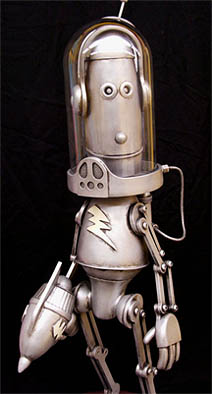 Lawrence Northey’s sculptures of robots, rockets, and ray guns (oh my!) are what you’d have to call out of this world.
Lawrence Northey’s sculptures of robots, rockets, and ray guns (oh my!) are what you’d have to call out of this world.
Like the artists who created the Faberge eggs he admires, Northey uses a variety of materials and techniques. Most of these pieces feature brass, stainless steel, and glass. Sometimes cast aluminum or cast resin parts are also used, typically hand painted to give a uniform finish with the other parts.
While most of these pieces are pure sculpture, in sizes around thirty inches in heght, there’s also the amazing “Dave the Robot Lamp”, which lights up in eerie warm colors – pretty dang extraterrestrial, in fact.
Northey does commission work as well as selling made-to-order series – like “Dave the Robot“, at right, and the cast aluminum “Silver Edition Raygun“.
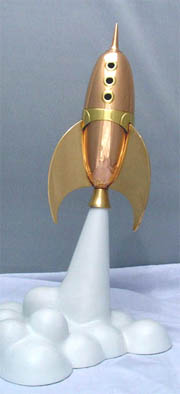
One of the fascinating things about these works is that although they’re obviously inspired by retro-futuristic toys from the 30s through the 50s, they’re made with exacting craftsmanship and detail that recalls early European art deco objects. Consequently you’ll find that they’re priced as artworks, not knicknacks. Judging by the samples on his site they’re worth every penny.
Some of his commissioned work is animatronic – lighting up. moving, and making sounds, even music. And like your chronically project-obsessed correspondent, he’s tying these characters and ideas together into a story which he calls “Wired City”.
Not to be missed!
This entry was posted on Thursday, August 16th, 2007
and was filed under Found on the Web
There have been 2 Responses »
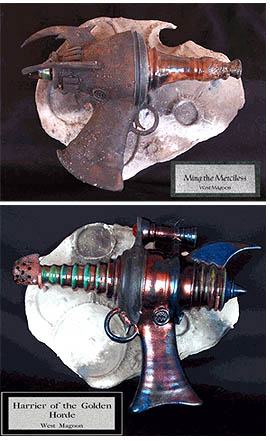 West Magoon could be the name of a mysterious galactic cluster that emanates destructive varioplasmic rays, or – possibly – the moniker of an art deco city floating in the clouds over Edgar Rice Burroughs’ Barsoom. In fact, in a perfect world it would probably be both of those things.
West Magoon could be the name of a mysterious galactic cluster that emanates destructive varioplasmic rays, or – possibly – the moniker of an art deco city floating in the clouds over Edgar Rice Burroughs’ Barsoom. In fact, in a perfect world it would probably be both of those things.
In this imperfect one, though, it’s the name of a ceramicist in Wyoming who does lots of interesting work – none more interesting, though, than his one-of-a-kind series of ceramic ray guns with Raku glazes.
Each one of these ray guns is made individually from a series of parts turned on a potter’s wheel. They’re assembled and glazed, mounted, and named after science fiction authors or the characters from their stories. Every one is unique.
Shown here are the “Ming the Merciless” ray gun and the “Harrier of the Golden Horde” model. Each of these two has already sold as I write this, but there are many more to choose from – and he doesn’t seem to be done with them yet. At present there are two pages of these Raku blasters and an archive of those which have already gone on to arm their Omniscient Overlords. Of which, dear reader, you could be one.
This entry was posted on Wednesday, August 15th, 2007
and was filed under Found on the Web
There have been no responses »

 “A Summoner” is really just a brief scene, followed by clips that show off the modeling work that lies behind it. There’s a lovely storybook mood and style here and it feels quite painterly. It’s worlds away from the harder edged photorealistic work we generally expect from 3D rendering applications (here, Maya).
“A Summoner” is really just a brief scene, followed by clips that show off the modeling work that lies behind it. There’s a lovely storybook mood and style here and it feels quite painterly. It’s worlds away from the harder edged photorealistic work we generally expect from 3D rendering applications (here, Maya).
Warning: it loaded excruciatingly slowly for me. Go make some coffee or catch up on your email, have patience, and enjoy.
This entry was posted on Monday, August 13th, 2007
and was filed under Computer Graphics, Found on the Web
There have been no responses »
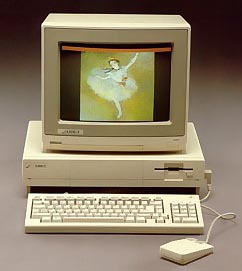 The second article in Ars Technica’s History of the Amiga is now online; if you missed it, I mentioned Part 1 earlier.
The second article in Ars Technica’s History of the Amiga is now online; if you missed it, I mentioned Part 1 earlier.
This installment lays out the important groundwork for what became the Amiga computer and – notably – its custom chipset, which used coprocessors to handle graphics and sound in ways that were several years ahead of its time. In fact, the Amiga included some features that have yet to be duplicated. We see the addition of R. J. Mical to the Amiga team (though not yet, by name, other engineeers like Dale Luck and Carl Sassenrath) and we see how a timely slump in game console sales revealed the engineers’ hidden agenda: to create something that could be a game machine, but which was also the foundation of an advanced personal computer with groundbreaking multimedia capabilities. For once, their agenda and that of their backers converged.
This is probably not as fascinating as the last installment – or, I expect, the next – but if you’re not familiar with the background of the machine you’ll learn a good deal here that will be important in the next chapter. What we see is how the team transmogrified their project, kept it under wraps, and did the fundamental work that they still needed to implement in hardware.
This entry was posted on Monday, August 13th, 2007
and was filed under Computer Graphics
There have been no responses »














 Here’s something I think is pretty fun, even though I can’t exactly wear it myself – women’s T-shirts for the “Retropolis Ladies’ World Domination Society”.
Here’s something I think is pretty fun, even though I can’t exactly wear it myself – women’s T-shirts for the “Retropolis Ladies’ World Domination Society”.











